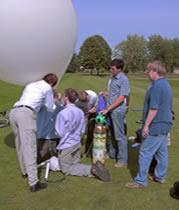 Project Nova captured dramatic pictures of Earth on its three-hour voyage.University of Cambridge, UK
Project Nova captured dramatic pictures of Earth on its three-hour voyage.University of Cambridge, UKImagine you have an important experiment you're just itching to launch into space, but you've only a few hundred in the bank. Who you gonna call? Well you could try a group of undergraduates at the University of Cambridge, UK.
The group have just catapulted themselves to the forefront of the budget space scene, with the successful testing of Project Nova, a system that could hopefully allow small payloads to be sent into space for just £1,000 (US$1,900) a pop.
This week, the team launched a 2-metre-wide helium balloon from the university campus. By the time it landed, 3 hours later and 45 kilometres away, it had soared to more than 32,000 metres, four times the height of Everest, recording stunning images of Earth before the balloon burst and the cameras and other instruments were guided groundwards by a parachute.
The project team, spearheaded by students Carl Morland, Henry Hallam and Robert Fryers, now plans to attach a rocket to the balloon that could be fired once the balloon nears its maximum height, speeding the payload to an ultimate height of more than 100 kilometres — the officially recognized boundary of space.
There are a series of further balloon tests planned for the coming months, culminating with a trial of the rocket technology in summer 2007. "The reliability will not be 100%," admits Hallam, who developed the balloon's tracking system. But at least the equipment will be recoverable, he adds.
The team is hoping to encourage local secondary schools and atmospheric scientists to put experiments on future launches, perhaps to measure ozone levels or pressure and temperature changes.
Amateur rocketeers
 Balloons offer a cheap way to travel the first few thousand metres towards space.University of Cambridge, UK
Balloons offer a cheap way to travel the first few thousand metres towards space.University of Cambridge, UKNo one else is planning space shots on such a paltry budget, says Paul Collins, a Cambridge engineer who advised the team. But the idea has an honourable precedent: in 1949, the famed US space scientist James Van Allen unveiled his 'rockoon', which involved a similar principle of using a balloon to take a rocket to a more convenient launch altitude. During testing in the 1950s the design, aimed at studying Earth's high-altitude magnetic field, met with some success. But rockoons frequently failed and their erratic range meant they could only be fired from seagoing vessels.
True amateur rocketeers have made it into space before — but not quite this cheaply. In May 2004, a rocket developed by the Civilian Space Exploration Team with commercial backing from the sports and energy drink company GoFast, successfully blasted into space from the Black Rock Desert, Nevada. Accelerating up to Mach 5, the craft tore more than 115 kilometres into space before falling back to Earth.
Most people dabbling in the technology are extraordinarily well funded. The altogether bolder project of SpaceShipOne, which in 2004 claimed the Ansari X-prize for the first private rocket capable of reaching space, was bankrolled by megarich Microsoft cofounder Paul Allen.
Not all such attempts are successful. Earlier this year, the privately built, $6.7-million Falcon 1 rocket slipped its reins less than a minute into its test flight (see 'Private rocket crashes and burns')
Good luck
ADVERTISEMENT
Although the Cambridge team should not approach the rocket phase of their effort lightly, they shouldn't worry too much about any failure being too ignominious.
They have arguably already done better than the commercial arm of the British government defence research lab, QinetiQ, which failed in its attempt to fly a balloon to 40 kilometres (see '"Burst balloon dashes launch hopes": http://www.nature.com/news/2003/030901/full/030901-4.html').
By using the balloon to travel the first few dozen kilometres, bypassing the area where gravity is strongest and the air thickest, the Cambridge team will not have to use as much fuel for their rocket. They are now looking for commercial backers to help them make the final push into the last frontier.
Visit our forspaceona_shoest.html">newsblog to read and post comments about this story.
